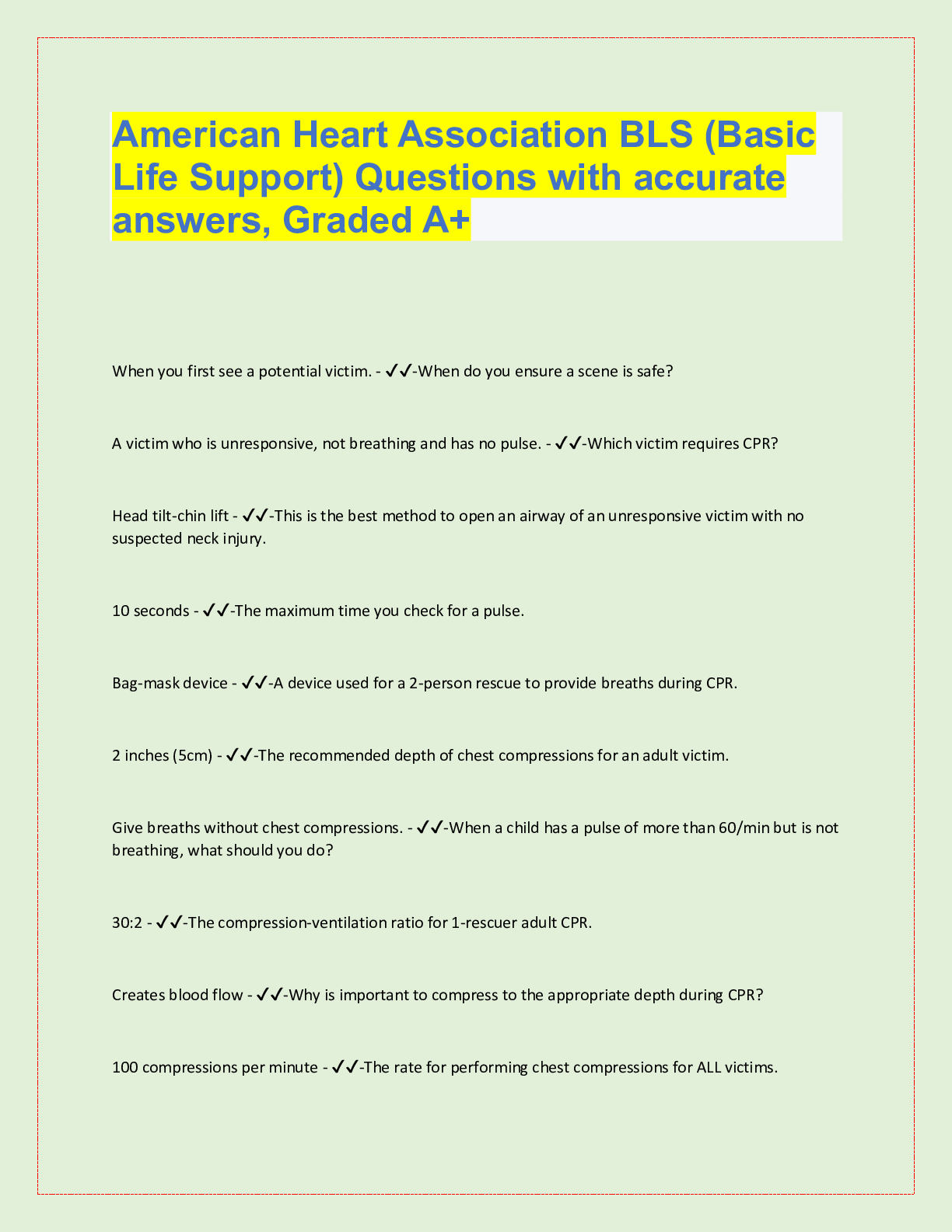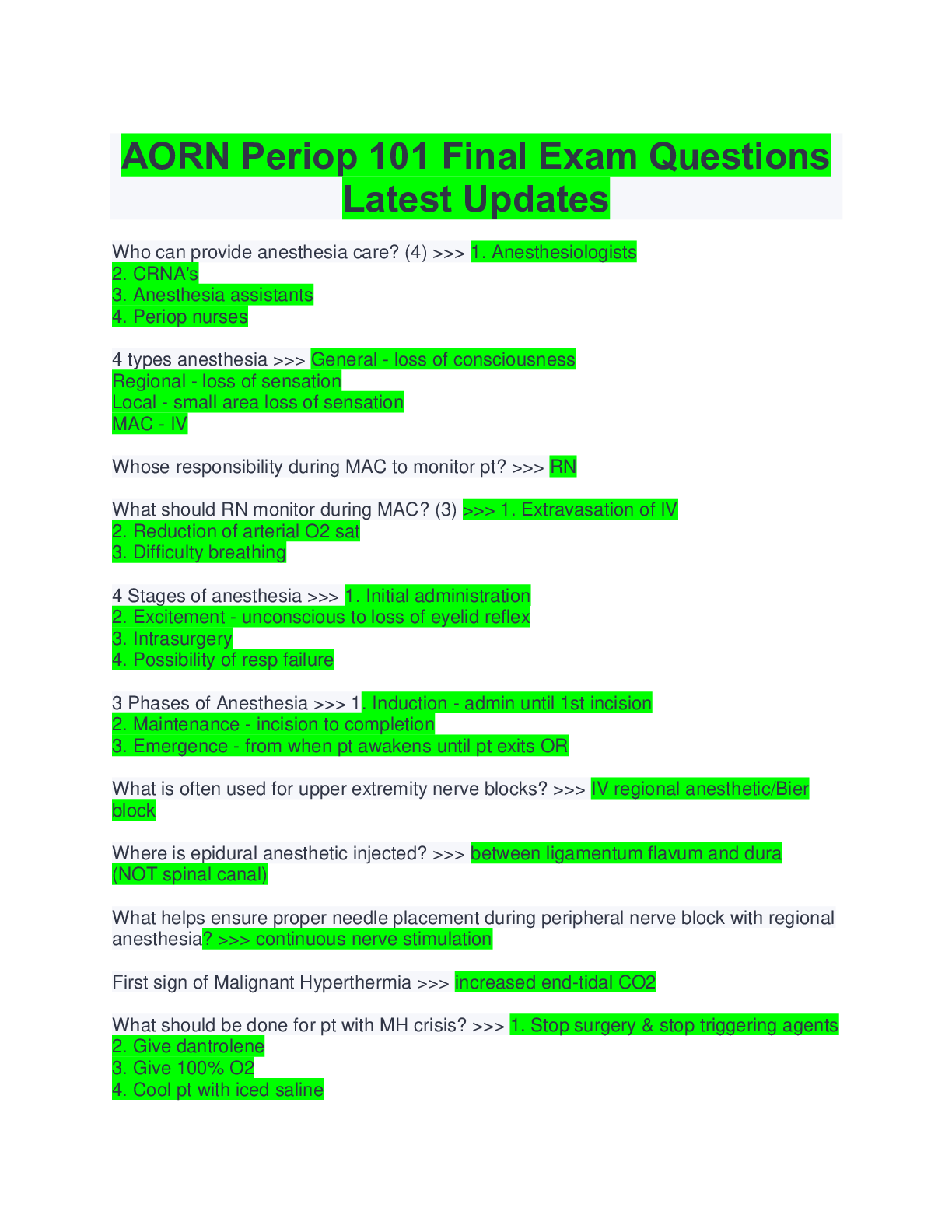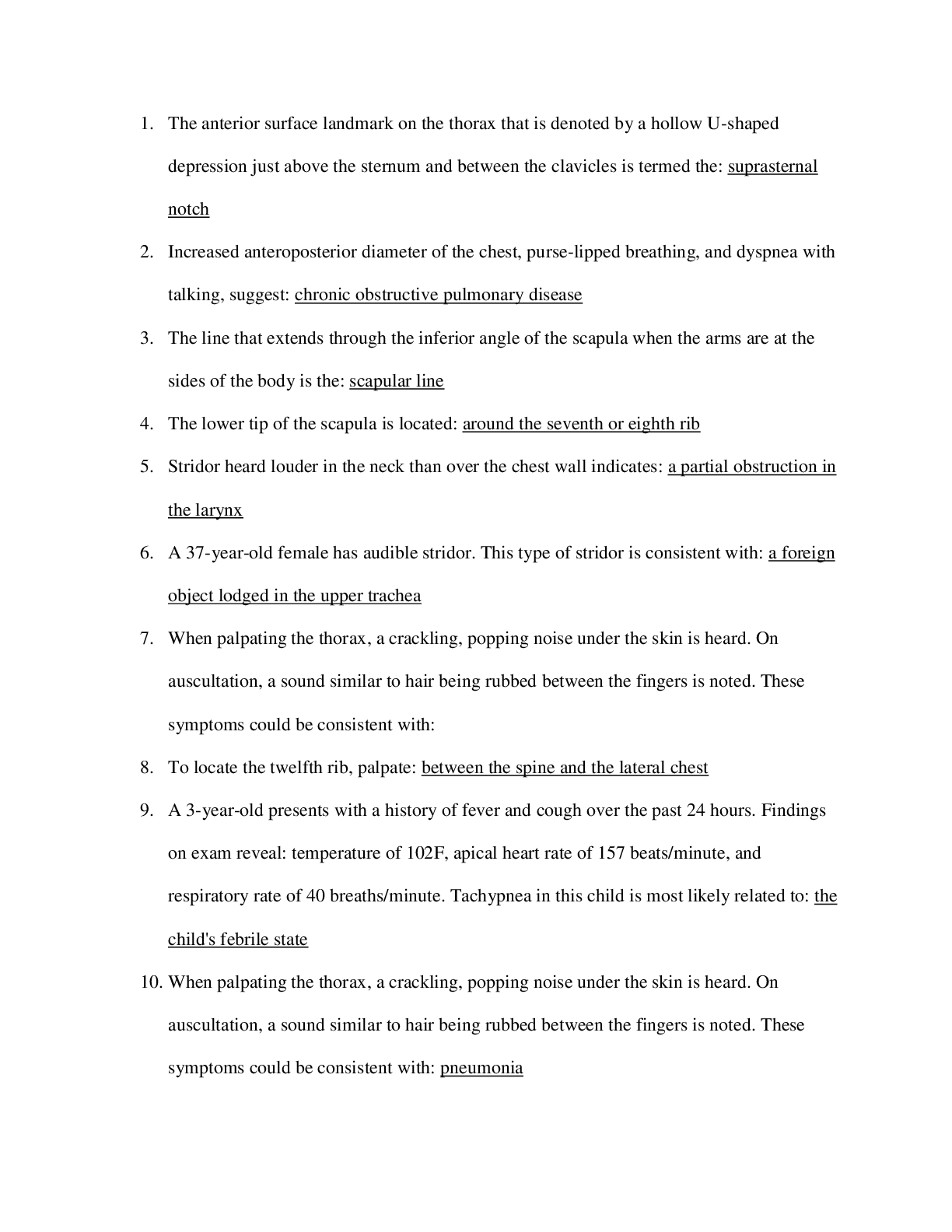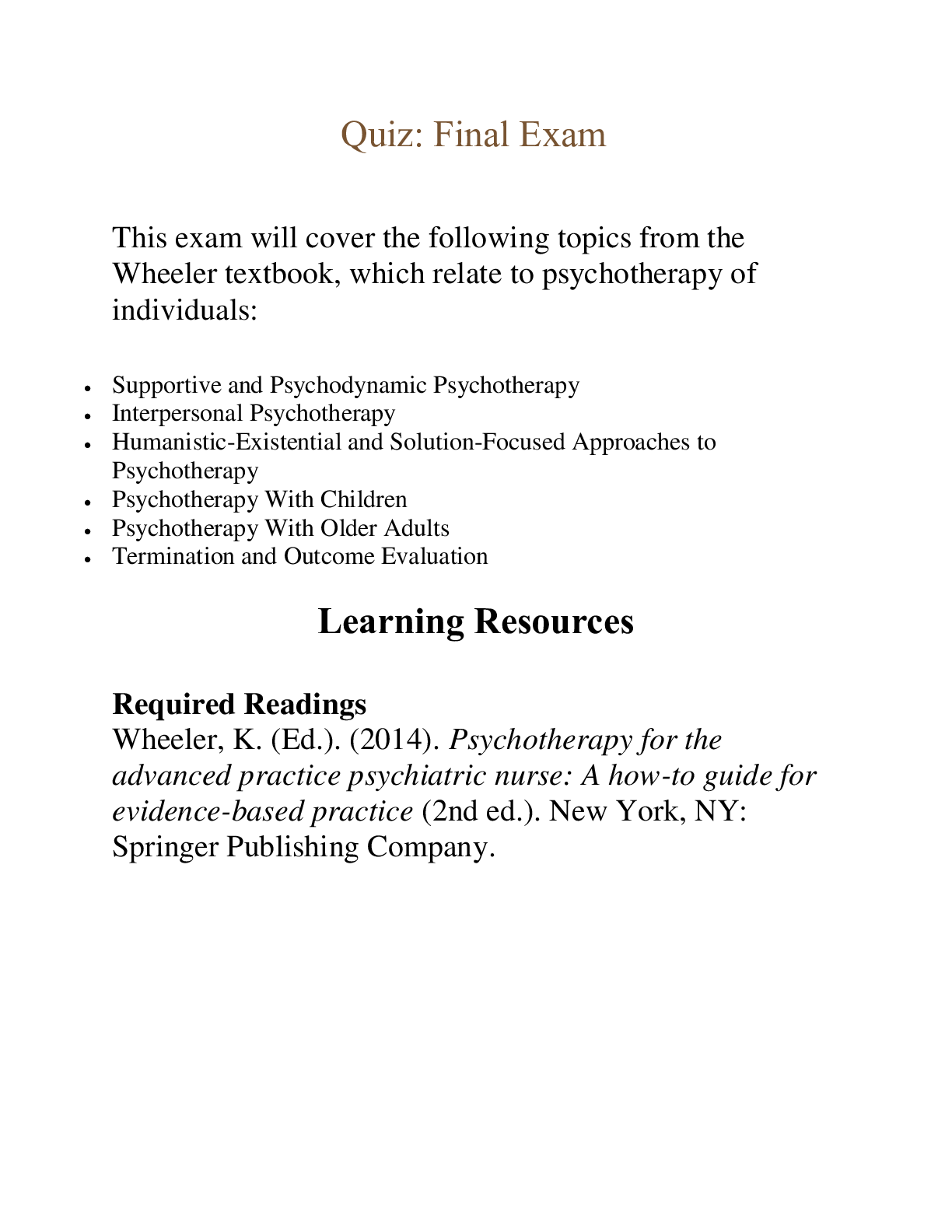*NURSING > QUESTIONS & ANSWERS > Musculoskeletal AAFP questions with accurate answers, graded A+. download to score (All)
Musculoskeletal AAFP questions with accurate answers, graded A+. download to score
Document Content and Description Below
Musculoskeletal AAFP questions with accurate answers, graded A+ Osteoporotic bone loss can be caused or accelerated by prolonged use of which one of the following medications? - ✔✔B. Phenytoi... n Anticonvulsants such as phenytoin increases the hepatic metabolism of vitamin D--which reduces intestinal calcium absorption Thiazide diuretics ( HTCZ) reduce urinary calcium loss - ✔✔believed to preserve bone density with long term use Raloxifene, a selective estrogen receptor modulator, is indicated for the prevention and treatment of - ✔✔osteoporosis in postmenopausal women. A 56-year-old female has been on combined continuous hormone therapy for 6 years. This is associated with a reduced risk for which one of the following? - ✔✔A. Bone fracture Risk for myocardial infarction, stroke, breast cancer, and venous thromoboembolism increased with longer term use. A 2-week-old female is brought to the office for a well child visit. The physical examination is completely normal except for a clunking sensation and feeling of movement when adducting the hip and applying posterior pressure. Which one of the following would be the most appropriate next step? - ✔✔A. Referral for orthopedic consultation Developmental dysplasia oh the hip: subluxation and dislocation of the newborn hip Common in : firstborns, females, breech presentations, oligohydramnios and patients with a family history of delopmental dysplasia. A 55-year-old overweight male presents with a complaint of pain in the left big toe. He recently started jogging 2 miles a day to try to lose weight, but has not changed his diet and says he drinks 4 cans of beer every night. The pain has developed gradually over the last 2 weeks and is worse after running. An examination shows a normal foot with tenderness and swelling of the medial plantar aspect of the left first metatarsophalangeal joint. Passive dorsiflexion of the toe causes pain in that area. Plantar flexion produces no discomfort, and no numbness can be appreciated. Which one of the following is the most likely diagnosis? - ✔✔A. Sesamoid fracture MTP joint has two sesamoid bones and injuries to these b ones account for 12% of big toe injuries Gout - ✔✔involves the first MTP joint but the onset is sudden with warmth, redness, and swelling and pain on movement of the joint is common. Morton's neuroma - ✔✔occurs b/e the 3rd and 4th toes and cause numbness involving the digital nerve in the are and caused by the nerve being pinched between metatarsal heads in the center of the foot. A mother brings in her 2-month-old infant for a routine checkup. The baby is exclusively breastfed, and the mother has no concerns or questions. Which one of the following would you recommend at this time in addition to continued breastfeeding? - ✔✔Vitamin D supplementation Cereal should not be started until 4 to 6 months of age. A 62-year-old white male complains of fatigue and proximal extremity discomfort without any localized joint pain. Which one of the following conditions is associated with a consistently normal creatine kinase enzyme level at all phases of disease? - ✔✔A. Polymyalgia rheumatica Polymyalgia rheumatica is a disease of the middle-aged and elderly. Discomfort is common in the neck, shoulders, and hip girdle areas. There is an absence of objective joint swelling, and findings tend to be symmetric. Characteristically, the erythrocyte sedimentation rate and C-reactive protein levels are significantly elevated; however, these tests are nonspecific. Occasionally there are mild elevations of liver enzymes, but muscle enzymes, including creatine kinase, are not elevated in this disorder Which one of the following is a risk factor for osteoarthritis of the hip? - ✔✔Risk factors for osteoarthritis of the hip include obesity, high bone mass, old age, participation in weight-bearing sports, and hypothyroidism. The daily intake of vitamins and minerals recommended by the Food and Nutrition Board varies according to sex, age, and condition. The recommended daily allowance of vitamin D is greatest for which one of the following? ( - ✔✔age of 75. The current Dietary Reference Intake (DRI - which has replaced RDA's) recommendation for vitamin D is 200 IU/day for all women between the ages of 9 and 50 years; pregnancy or lactation does not affect the recommendation. The DRI doubles to 400 IU daily for women age 51-70 and triples to 600 IU daily for women over the age of 70. The maximum daily oral intake of vitamin D thought to be safe is 2000 IU/day for all females over the age of 12 months. In addition to calcium and vitamin D supplementation, patients who are beginning long-term treatment with prednisone (≥3 months at a dosage ≥5 mg/day) should also receive - ✔✔bisphosphonate therapy The American College of Rheumatology recommends that patients who are beginning long-term treatment with prednisone (≥3 months at a dosage ≥5 mg/day), or an equivalent, receive bisphosphonate therapy in addition to calcium and vitamin D supplementation, regardless of their DEXA-scan T score. A 79-year-old male is admitted to the hospital because of a sudden inability to ambulate. He has a past history of gout. On examination his temperature is 38.2°C (100.8°F) and he has bilateral knee effusions. His WBC count is 14,000/mm3 with 82% segs. His serum uric acid level is 8.5 mg/dL (N <6.5). Which one of the following would be most appropriate at this point? - ✔✔B. Arthrocentesis Polyarticular arthritis often presents with fever, knee and other joint effusions, and leukocytosis. Recall that Allopurinol should not be initiated during an acute gouty attack, but may be started after a patient has recovered while Diuretics increase uric acid levels. An overweight 13-year-old male presents with a 3-week history of right lower thigh pain. He first noticed the pain when jumping while playing basketball, but now it is present even when he is just walking. On examination he can bear his full weight without an obvious limp. There is no localized tenderness, and the patella tracks normally without subluxation. Internal rotation of the hip is limited on the right side compared to the left. Based on the examination alone, which one of the following is the most likely diagnosis? - ✔✔Answer: Slipped capital femoral epiphysis Pain with activity is the most common presenting symptom, as opposed to the nighttime pain that is typical of malignancy. Obese males are affected more often. The pain is [Show More]
Last updated: 1 year ago
Preview 1 out of 8 pages
Instant download

Buy this document to get the full access instantly
Instant Download Access after purchase
Add to cartInstant download
Also available in bundle (1)

ALL AAFP BUNDLE. LATEST VERSIONS, 2022
RATED A+ MASTERPIECES. ALL AAFPA EXAM DOCUMENTS
By bundleHub Solution guider 1 year ago
$35
10
Reviews( 0 )
Document information
Connected school, study & course
About the document
Uploaded On
Aug 18, 2022
Number of pages
8
Written in
Additional information
This document has been written for:
Uploaded
Aug 18, 2022
Downloads
0
Views
71
















 Questions and Answers with Explanations, 100% Correct, Download to Score A.png)
 Questions and Answers (latest Update), 100% Correct, Download to Score A.png)
, 100% Correct, Download to Score A.png)
, 100% Correct, Download to Score A.png)
, 100% Correct, Download to Score A.png)
 Questions and Answers (latest Update), 100% Correct, Download to Score A.png)
, 100% Correct, Download to Score A.png)

